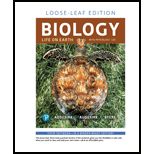
Concept explainers
Introduction: Ribonucleic acid (RNA) is a
Answer to Problem 1MC
Correct answer: Option b. “messenger RNA”.
Explanation of Solution
Reason for the correct answer:
Option b. is given as “messenger RNA”.
Messenger RNA (mRNA) functions as an information carrier from DNA in the nucleus to the ribosome in cytoplasm of the cell. This information is used by the cell to direct the synthesis of proteins. Group of three bases in mRNA is called codons that specify which amino acid will be incorporated into a protein.
Hence, option b. is correct.
Reasons for incorrect answers:
Option a. is given as “ribosomal RNA”.
Ribosomal RNA is responsible for the production of ribosomes at which polypeptide chains are formed during translation. Hence, option a. in incorrect.
Option c. is given as “transfer RNA”.
Transfer RNA transfers the amino acid to the ribosomal unit in translation process by which the information in mRNA is translated into protein molecules. Hence, option c. is incorrect.
Option d. is given as “noncoding RNA”.
Non-coding RNA is transcribed from DNA, but is not translated into proteins.
Hence, option d. is incorrect.
Hence, options a., c., and d. are incorrect.
Messenger RNA carries the genetic information from DNA to the cytoplasm which is then used for protein synthesis.
Want to see more full solutions like this?
Chapter 13 Solutions
Pearson eText Biology: Life on Earth with Physiology -- Instant Access (Pearson+)
- Which of the following is not a type of RNA?a. nRNA (nuclear RNA)b. mRNA (messengerc. rRNA (ribosomal RNA)d. tRNA (transfer RNA)arrow_forwardFor each of the following, identify the type of RNA involved (mRNA, rRNA, or tRNA). a. Transports the correct amino acid to the ribosome, using the information encoded in the mRNA. b. Is a major component of ribosomes. c. Specifies the order of amino acids in a protein, using a series of three-base codons, where different amino acids are specified by particular codons. d. Contains a three-base anticodon that pairs with a complementary codon revealed in the mRNA. e. Assists in making the bonds that link amino acids together to make a protein.arrow_forwardDefine the following terms: a. rRNA b. tRNA c. mRNA d. siRNA e. miRNAarrow_forward
- Which of the following statements about codons in prokaryotic cells and eukaryotic cells is correct? A. Prokaryotic codons are longer than eukaryotic codons. B. Eukaryotic codons are made of DNA, and prokaryotic codons are made of RNA. C. Prokaryotes do not have mRNA, so there are no codons. D. Codons are very similar, no matter whether the cell is prokaryotic or eukaryotic.arrow_forwardWhich of the following statements are NOT true? A. Replication is the process of making DNA and takes place in the nucleus of prokaryotic cells. B. Translation produces a polypeptide that may require additional processing to become a functional protein C. Transcription starts at the promoter of eukaryotic cells and scans until reaches the start codon. D. Splicing results in exons being put together and introns being removedarrow_forwardWhich of the following is the definition of a gene? A. RNA that delivers amino acids to a ribosome during translation B. A unit of information encoded in the sequence of nucleotide bases in DNA C. The RNA component of ribosomes D. RNA that carries a protein-building messagearrow_forward
- Which of the following nucleic acids is a component of ribosomes? a.DNA b.Transfer RNA c.Ribosomal RNA d.Messenger RNAarrow_forwardSelect the description of an intron. (If possible, please explain why it is that answer) a.) sequence of adenine nucleotides added onto the end of pre‑mRNA b.) modified form of a guanine nucleotide added onto the end of pre‑mRNA c.) coding portion of a DNA sequence that is present in mature mRNA d.) noncoding portion of a DNA sequence that is removed from pre‑mRNAarrow_forwardIf you imagine a messenger RNA molecule in the cytoplasm of a cell, which of the following will likely affect how much protein is made by translation of this message? A. The presence of appropriate snRNPs. B. The length of the polyA tail. C. The strength of hydrogen bonds holding the mRNA to ribosomal RNA. D. The ability of the mRNA to pair with itself to form a helix-turn-helix structure.arrow_forward
- Which of the following molecule functions in the SAME compartment in which it is synthesized? A. mRNA B. tRNA C. snRNA D. rRNAarrow_forwardWhich of the following are encoded in the terminating codon in protein synthesis? a. Selenocycteine and Pyrrolysine b. GABA and Homocysteine c. Hydroxyproline and Selenocycteine d. Ornithine and Citrullinearrow_forwardArrange the statements in their proper order by writing the corresponding letter (e.g. A) for each statement in the space provided below. A. The single-stranded RNA would complement the target RNA. B. Gene expression is inactivated once the mRNA is no longer accessible for translation. C. The risk-induced silencing complex which is composed of RNA and protein subunits is formed. D. Double-stranded, non-coding RNA is cleaved by Dicer. E. The mRNA can be cleaved or remain bound by the RISC. 1. 2. 3. 4. 5.arrow_forward
 Human Anatomy & Physiology (11th Edition)BiologyISBN:9780134580999Author:Elaine N. Marieb, Katja N. HoehnPublisher:PEARSON
Human Anatomy & Physiology (11th Edition)BiologyISBN:9780134580999Author:Elaine N. Marieb, Katja N. HoehnPublisher:PEARSON Biology 2eBiologyISBN:9781947172517Author:Matthew Douglas, Jung Choi, Mary Ann ClarkPublisher:OpenStax
Biology 2eBiologyISBN:9781947172517Author:Matthew Douglas, Jung Choi, Mary Ann ClarkPublisher:OpenStax Anatomy & PhysiologyBiologyISBN:9781259398629Author:McKinley, Michael P., O'loughlin, Valerie Dean, Bidle, Theresa StouterPublisher:Mcgraw Hill Education,
Anatomy & PhysiologyBiologyISBN:9781259398629Author:McKinley, Michael P., O'loughlin, Valerie Dean, Bidle, Theresa StouterPublisher:Mcgraw Hill Education, Molecular Biology of the Cell (Sixth Edition)BiologyISBN:9780815344322Author:Bruce Alberts, Alexander D. Johnson, Julian Lewis, David Morgan, Martin Raff, Keith Roberts, Peter WalterPublisher:W. W. Norton & Company
Molecular Biology of the Cell (Sixth Edition)BiologyISBN:9780815344322Author:Bruce Alberts, Alexander D. Johnson, Julian Lewis, David Morgan, Martin Raff, Keith Roberts, Peter WalterPublisher:W. W. Norton & Company Laboratory Manual For Human Anatomy & PhysiologyBiologyISBN:9781260159363Author:Martin, Terry R., Prentice-craver, CynthiaPublisher:McGraw-Hill Publishing Co.
Laboratory Manual For Human Anatomy & PhysiologyBiologyISBN:9781260159363Author:Martin, Terry R., Prentice-craver, CynthiaPublisher:McGraw-Hill Publishing Co. Inquiry Into Life (16th Edition)BiologyISBN:9781260231700Author:Sylvia S. Mader, Michael WindelspechtPublisher:McGraw Hill Education
Inquiry Into Life (16th Edition)BiologyISBN:9781260231700Author:Sylvia S. Mader, Michael WindelspechtPublisher:McGraw Hill Education





